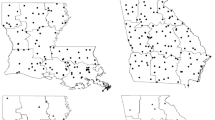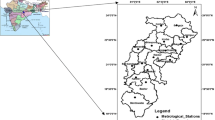Abstract
This study uses correlation and multiple regression techniques to document differences in annual and seasonal precipitation trends between the NCDC Climate Division database and the United States Historical Climate Network (USHCN) in the southeast United States. Findings indicate that the majority of climate divisions have different temporal patterns than those depicted by the USHCN. They did not, however, consistently possess statistically significant relationships between the ratio (CDD/USHCN) and changes in mean station location as noted in other studies. It appears that other influences cause the majority of the variance between the two datasets. The fact that the two datasets do not consistently agree, however, suggests that spuriously induced trends may be present in the NCDC Climate Division database.



Similar content being viewed by others
References
Allard J, Keim BD (2007) Spuriously induced temperature trends in the southeast United States. Theor Appl Climatol 88:103–110
Diem JE, Mote TL (2005) Interepochal changes in summer precipitation in the southeastern United States: evidence of possible urban effects near Atlanta, Georgia. J Appl Meteorol 44:717–730
Easterling DR, Karl TR, Mason EH, Hughes PY, Bowman DR, Daniels RC, Boden TA (1996) United States historical climatology network (U.S. HCN) monthly temperature and precipitation data. Oak Ridge, Tenn: ESD Publ. 4500, ORNL/CDIAC-87 NDP-019/R3
Gutman NB, Quayle TB (1996) A historical perspective of U.S. Climate divisions. Bull Am Meteorol Soc 77:293–303
Karl TR, Williams Jr CN, Young PJ, Wendland WM (1986) A model to estimate the time of observation bias with monthly mean maximum, minimum, and mean temperatures for the United States. J Clim Appl Meteorol 25:145–160
Karl TR, Diaz HF, Kukla G (1988) Urbanization: its detection and effect in the United States climate record. J Clim 1:1099–1123
Karl TR, Knight RW, Easterling DR, Quayle RG (1996) Indices of climate change for the United States. Bull Am Meteorol Soc 77:279–292
Karl TR, Williams Jr CW (1987) An approach to adjusting climatological time series for discontinuous inhomogeneities. J Clim Appl Meteorol 26:1744–1763
Keim BD Faiers GE, Muller RA, Grymes III JM, Rohli RV (1996) Long-term trends in precipitation and runoff in Louisiana. Int J Climatol 15:279–292
Keim BD, Fisher MR, Wilson AM (2005) Are there spurious precipitation trends in the United States climate division database? Geophys Res Lett 32(4), L04702, DOI 10.1029/2004GL021985
Keim BD, Wilson AM, Wake CP, Huntington TG (2003) Are there spurious temperature trends in the United States Climate Division Database? Geophys Res Lett 30(7), 1404, DOI 10.1029/2002GL016295
Leathers DJ, Grundstein AJ, Ellis AW (2000) Growing season moisture deficits across the northeastern United States. Clim Res 14:43–55
Muller RA, Keim BD, Hoff JL (1990) Application of climatic divisional data to flood interpretations: an example from Louisiana. Phys Geogr 11:353–362
Quayle RG, Easterling DR, Karl TR, Hughes PY (1991) Effects of recent thermometer changes in the cooperative station network. Bull Am Meteorol Soc 72:1718–1724
Southeast Regional Assessment Team (2002) Preparing for a changing climate: the potential consequences of climate variability and change–Southeast. U.S. Global Change Program
Author information
Authors and Affiliations
Corresponding author
Rights and permissions
About this article
Cite this article
Allard, J., Keim, B.D., Chassereau, J.E. et al. Spuriously induced precipitation trends in the southeast United States. Theor Appl Climatol 96, 173–177 (2009). https://doi.org/10.1007/s00704-008-0021-9
Received:
Accepted:
Published:
Issue Date:
DOI: https://doi.org/10.1007/s00704-008-0021-9




